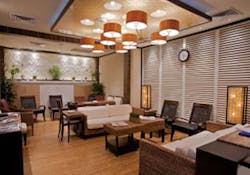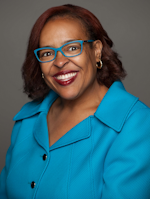Independent airport lounges have been a regular thing outside the United States for more than 10 years, while U.S. travelers have always relied on gaining access to airline-branded airport lounges. But that is now changing.
Companies like Airport Lounge Development (ALD), Escape Lounges and Graycliff are showing up at airports including Phoenix Sky Harbor, Cincinnati/Northern Kentucky International and Minneapolis-St. Paul International. Some are offering alternatives to existing airline clubs, while others are filling what they see as a gap in service.
Henry Harteveldt, founder and travel industry analyst for San Francisco-based Atmosphere Research Group, notes that several factors have contributed to the growth of independent airport lounges in the U.S. “First and foremost is that the real estate is available. Airlines had lounges and vacated them and airports wanted to find new ways to use them, so these operators stepped in,” he said.
Second, dwell times in airports have increased, Harteveldt said. “Passengers are spending more time at airports because sometimes TSA lines work well and sometimes they don’t. So travelers get to the airport earlier and once they pass security, they have time to kill until their flights,” he said. “Significant numbers of business and leisure travelers are willing to spend extra money to have a more comfortable trip, and lounges are part of that comfort.”
Demand Grows
Nancy Knipp is the senior vice president at Airport Lounge Development Inc. (ALD), which operates The Club at eight facilities: Atlanta, Cincinnati, Dallas/Fort Worth, Las Vegas, Orlando, Phoenix, Seattle and San Jose. She believes that there are now forces at work in the United States that are fueling demand for independent lounges.
“The airlines dominated the lounge industry for years. But as they make changes, they are becoming a lot more exclusive when it comes to who gets into their lounges,” said Knipp, who was previously president and managing director for American Airlines’ Admirals Clubs. “They are making a lot more investment in their lounges, and that investment has really driven them to try and differentiate the experience for their most important customers. The airlines are becoming a lot more exclusive in deciding who gets in.”
Another issue driving the growth of independent clubs is the rise of international travelers and airlines coming into the U.S., Knipp said, who noted numbers of nearly a 20 percent increase.
“You have people coming over to the U.S. who are used to having access to lounges,” she said. “They are coming to the U.S. and demanding them. And as international airlines fly into the U.S., they are looking for a lounge product, but unfortunately, there just isn't the room to have each airline have their own lounge. All of this has led to a sort of the perfect storm for independent lounges to really take off.”
Rosemarie Andolino is president and CEO of Manchester Airports Group USA (MAG) who previously served as commissioner of aviation for the city of Chicago, including O’Hare and Midway airports. MAG, which operates independent lounges in the U.K., opened the Escape Lounge at Minneapolis-St. Paul International Airport’s Terminal 1 in November 2015, and is opening outlets at Oakland International and Bradley International later this fall.
Andolino believes that independent lounges have grown in the U.S. because customers want more choices in their products.
“There was 5,000 square feet of space on the mezzanine level of Minneapolis-St. Paul with beautiful natural light, great views of the airfield and a great location that was being used for storage,” she said. “It’s just another option that airports can offer customers, because they do want choices. Airports are serving thousands of people a day and it's finding the mix of what those customers desire. Independent lounges like Escape offer one-stop shopping.”
Paolo Garzaroli manages outlets of the Graycliff Boutique & Divans at Cincinnati, Nashville and the Bahamas’ Lynden Pindling International airports. “Travelers are looking for alternate options to airline lounges for flexibility,” he said. “We have agreements with Priority Pass as well as other programs, so their members are frequent users and they get special benefits with us. They also are not locked into a single program that if you fly another airline you cannot use the lounge.”
That’s where shared lounges come in, said ALD’s Knipp. “Our lounges can be very beneficial for airports because you can actually have airlines that can use that lounge and they don't have to build their own,” she said.
But it is a sell to airports in the beginning. “Airports have to believe that a properly run independent lounge is an essential service. We took over old smoking lounges in Cincinnati and Nashville, upgraded them and made them a civilized place to be,” Garzaroli said. “In Nassau, there is no airline lounge, so with the new airport it was the ideal thing for us. We offer a premium service to the airport and the passengers. It allows them to escape to our oasis.”
The Right Fit
MAG meets with airports and educate them on what it has to offer, pointing it out as another option for customers, said Andolino. It provides the airport with revenue and customers a convenience and an option,” she said. “Not everybody is a frequent traveler, so they do not have membership to airline clubs. With Escape, they can access it anytime they travel.”
Knipp said that ALD focuses on the benefits of an independent lounge to airports. “It helps them better utilize real estate and serve international airlines that want to offer a lounge to their customers,” she said. “It also provides options to airlines that may want to offer a lounge product without having to build one. And the airport gets needed revenue from space that may not be otherwise utilized and offer travelers a welcomed service.”
The biggest audience for independent lounges is with customers that already have a Priority Pass card — a partner of ALD — in their pocket, Knipp said. “That membership gives them access to lounges around the world. Passengers can arrive early at the airport, where they spend money in the terminal, then go to the lounge to unwind,” she said.
Airports are looking for that right mix of products, which can include independent lounges, Andolino said. “And it’s a great amenity that airports can offer. Travelers get all the food they can eat and all the drinks. We have charging stations within our furniture and all over the lounge,” she said. “There are quiet places to read, people can then watch TV or do work They have access to iPads or print documents they may need.”
All three operators have criteria they use to determine which airports are ideal for independent lounges. For Graycliffs’ Garzaroli, it’s simple: airport traffic. “That’s followed by the location of the lounge in the terminal. As each airport is run differently we adjust our criteria to the location,” he said.
As for space needs, it depends on the size of the lounge, Garzaroli said. “In Nassau’s U.S. departures, we offer a full-service lounge with food, a full bar and three seating options: indoor air conditioned non-smoking, indoor air-conditioned smoking and an outdoor sundeck, at about 10,000 square feet,” he said. “In Nashville and Cincinnati, the size varies from 500 to 700 square feet, as we only offer smoking lounge options.”
One of the first things ALD does is look at the profile of an airport relative to domestic and international travel, said Knipp. “Ideally we want the optimum location in a market that draws international travelers because they tend to be a lot more lounge savvy,” she said. “If an airport comes to us and says we’re looking at adding a lounge, we have a model that we use to determine if it will fit, looking at things like space, traffic mix and enplanements. We actually map it out, so we can show them the peaks and the valleys based on their flight schedule, and tell them the optimal size of the lounge.”
ALD builds lounges to accommodate not just peak travel, but at least 20 percent above that, said Knipp. “In your lounge, you don't want travelers sitting on top of each other,” she said. “Our average lounge size is about 5000 square feet, but we have gone to as high as 7000 to 8000 square feet, so it depends on the airport.”
MAG looks at airports where it sees some voids, said Andolino. “Oakland put out an RFP for a lounge and we responded to it and were selected. Ideally, we're looking all airports, but they all have facilities and terminals that are unique and different,” she said. “So we access them one by one to determine what makes business sense and if there’s capacity and a market.”
A typical Escape Lounge is around 5,000 square feet, said Andolino. “But we have the ability to adjust and be flexible, delivering anything from 1,000 to 10,000 square feet.”
An Improved Customer Experience
ALD charges $40, while Graycliff lounges range from $6 to $11 in its U.S. lounges and $15 to $25 in the Bahamas. MAG charges $45 or $40 if you pre book a space.
The Club customers get complimentary beverages that includes alcohol, premiums beers and wines, said Knipp. “In the morning, we have yogurt, cereal, and some pastries, along with coffees and teas. As the day progresses, we put out selections of pastas, an olive bar, cheese sandwiches, fruit, and snacks,” she said. “One feature that has become popular is our gourmet popcorn selection, with flavors including dill pickle and sour cream and chives.”
Escapes Lounges offer have exceptional food and drinks with a local flavor, said Andolino. “There is always some selections of charcuterie, cheeses and salads. We serve breakfast, lunch and dinner and snacks are served all day long,” she said. “There’s also a menu where somebody can elect to purchase something of more substance, like shrimp and grits or a big burger.”
The Graycliff lounges offer Wi-Fi, televisions, newspapers and magazines, said Garzaroli. “All of our smoking lounges offer clean air through a sophisticated air filtration system that does a complete air exchange every 30 to 35 seconds,” he said. “In Cincinnati we include a drink.” Nassau offers one free soft drink and offers alcoholic beverages and sandwiches for sale.
Looking toward the future, ALD and MAG see growth, while Graycliff’s Garzaroli said his company is happy where it is for now.
“We have seven lounges in the U.S., we opened up one at London Heathrow Terminal 5 and we have a few more we are planning on announcing in the next couple of months,” said Knipp. “We are confident that we will have a minimum of 20 lounges in the next year as we continue to grow the brand. More and more airports are seeing the value of it. We are a sister company to Priority Pass, and we are the only lounge operator that guarantees access for those customers.”
MAG is now coast to coast, but there are so many airports that are ideal for an Escapes Lounge, said Andolino. “In five years, we hope we'll be in 10 to 20 more airports, creating a network of lounges that traveler could enjoy no matter what airport they are in the United States,” she said.
Harteveldt sees an enormous opportunity for independent lounges. “There are some airlines, like Southwest and JetBlue, have a national route network but don’t want to get into the lounge business,” he said. “So that creates opportunities for airports and entrepreneurs to serve an unserved market.”
There may be airports where an airline has a lounge but can’t justify it because of high costs or not enough traffic, said Harteveldt. “San Diego and Baltimore-Washington airports are great examples of this. The American Airlines Admiral’s Club in San Diego closed and United’s Red Carpet Club in Baltimore closed, so Airspace stepped in and took over both.” The Airspace Lounge in Baltimore has closed and ALD will take it over this fall.
The U.S. economy has improved and people want to take the edge off travel and lounges help do that, said Harteveldt. “Independent operators see an opportunity to serve underserved passengers in fragmented cities like Las Vegas, where it doesn’t make sense for airlines to operate a lounge,” he said.






